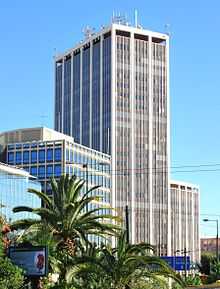Modern Greek architecture
After the Fall of Constantinople and the following trends of Greek migration to the diaspora, Greek architecture was concentrated mainly on the Greek Orthodox churches of Diaspora. These churches, such as other intellectual centres built by Greeks (foundations, schools, etc.), was used also as a meeting-place. The architectural style of these buildings was heavily influenced by the western European architecture.
After the Greek War of Independence and the creation of the modern Greek state, the modern Greek architecture tried to combine the traditional Greek architecture and Greek elements and motives with the western European movements and styles.
The 19th-century architecture of Athens and other cities of the Greek Kingdom is mostly influenced by the Neoclassical architecture, with architects like Theophil Hansen, Ernst Ziller and Stamatios Kleanthis.
Neoclassical examples
-
The Apollon Theatre of Patras, designed by Ernst Ziller (1872)
-

Korais public library of Chios (1885)
-

Municipal theatre of Piraeus (1895)
-

Old city hall of Mytilene (1900)
-

National Bank of Greece of Thessaloniki (1928)
In 1933 was signed the Athens Charter, a manifesto of the modernist movement which published later by Le Corbusier. Architects of this movement were among others: The Bauhaus-architect Ioannis Despotopoulos, Dimitris Pikionis, Patroklos Karantinos and Takis Zenetos.
After the World War II and the Greek civil war, the massive construction of condominiums in the major Greek city-centres, was a major contributory factor for the Greek economy and the post-war recovery. The first scycrapers were also constructed during the 1960s and 1970s, such as the OTE Tower and the Athens Tower Complex.
During the 1960s and 1970s, Xenia was a nation-wide hotel construction program initiated by the Hellenic Tourism Organisation (Ελληνικός Οργανισμός Τουρισμού, EOT) to improve the country's tourism infrastructure. It constitutes one of the largest infrastructure projects in modern Greek history. The first manager of the project was the architect Charalambos Sfaellos (from 1950 to 1958) and from 1957 the buildings were designed by a team under Aris Konstantinidis.
Famous foreign architects who have also designed buildings in Greece during the 20th and 21st century, include Walter Gropius, Eero Saarinen and Mario Botta. Several new buildings were also constructed by Santiago Calatrava for the 2004 Athens Olympics, while Bernard Tschumi designed the New Acropolis Museum.
Gallery
-

Tower houses of Mani peninsula
-

Traditional style houses in Nafplion
-

Rooftops of Plaka, the old Athenian neighborhood with the traditional style houses
-

Our Lady of Tinos (1830)
-
Villa Illision, designed by Stamatios Kleanthis (1848)
-

Colourful houses of Symi island
-
Houses of Agios Nikolaos, Chalkidiki, typical Greek village
-

Menetés village, Karpathos
-

Saint Andrew of Patras in Neo-Byzantine style (1908-1974)
-
The building of the National Bank of Greece in Nafplion in Mycenaean Revival architecture style (1930s)
-

OTE Tower of Thessaloniki, example of modernist architecture (1966)
-

Athens Tower Complex (1971)
-
Peace and Friendship Stadium (1985)
See also
External links
| ||||||||||||||||||||||||||||
| ||||||||||






